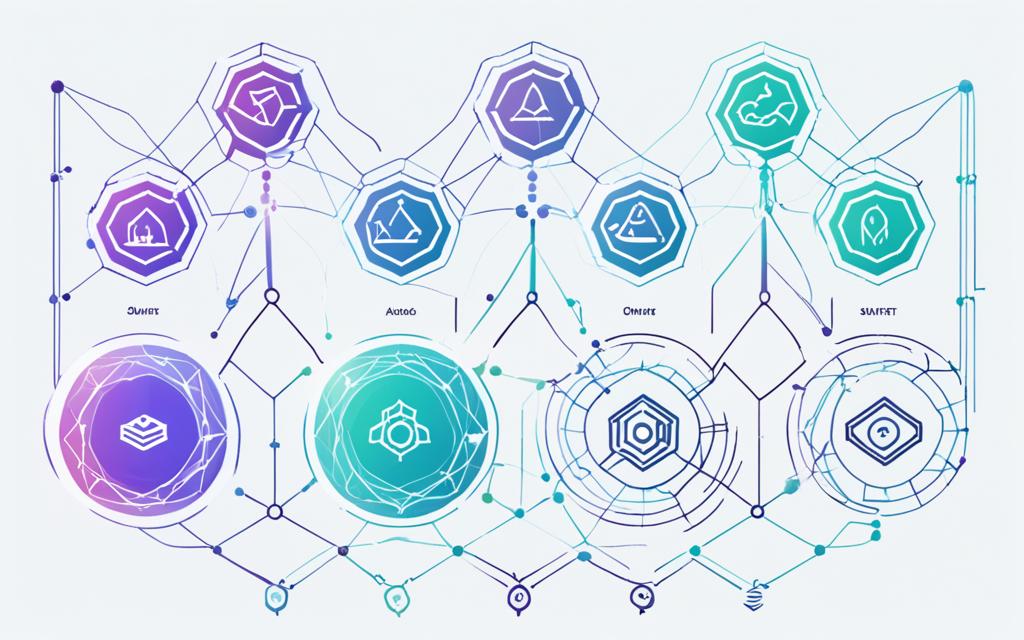Table of Contents
Avalanche is changing how we look at cryptocurrencies. It has a unique way to work with three main blockchains. These are the C-Chain, P-Chain, and X-Chain. Each one plays a key role in making the network run smoothly and securely.
The C-Chain is all about smart contracts. It helps people make and use contracts quickly and safely. This part is really important for developers working on new contracts.
The P-Chain helps in creating apps and managing assets. It’s designed to make apps work well without problems. It also makes sure assets are kept safe and easy to manage.
The X-Chain is for making exchanges. It’s great at moving lots of assets quickly and without delay. This makes trading easy and secure for everyone involved.
All these chains work together smoothly, thanks to special tech called atomic swap. So, moving assets between the chains is simple and efficient.
Key Takeaways
- Avalanche’s Primary Network consists of the Contract Chain (C-Chain), Platform Chain (P-Chain), and Exchange Chain (X-Chain).
- The C-Chain specializes in smart contracts, the P-Chain focuses on application development, and the X-Chain is designed for decentralized exchanges1.
- Avalanche’s blockchains offer fast transaction speeds, low latencies, and tailored smart contract languages1.
- By leveraging atomic swaps, Avalanche enables seamless interaction between its three blockchains2.
The Contract Chain (C-Chain)
The Contract Chain, known as the C-Chain, is key in the Avalanche system. It brings the Ethereum Virtual Machine (EVM) to life. This lets developers work with smart contracts using Solidity. The C-Chain works smoothly with Ethereum. So, developers can move their projects easily, making both networks work together. With it, they get the best of Ethereum’s smart contracts and Avalanche’s fast transactions. It can process over 4,500 transactions a second, taking less than a second to finalize3.
In using the C-Chain, developers can tap into a wide range of DApps and DeFi projects. This opens up loads of new things to try and ways to handle money. They can make all kinds of projects, like exchanges, loans, and asset tokens, using Solidity. This speeds up how fast people start using Avalanche for their smart contracts3.
The Advantages of the C-Chain
The C-Chain has many upsides that make it attractive and user-friendly. First, it works with the EVM, making it easy for Ethereum developers to join. This means less fuss and more time creating. And, it’s faster and handles more transactions than Ethereum or Bitcoin. It can do 4,500 transactions a second, beating other popular blockchains4.
Moving on, the C-Chain tackles a big issue: high transaction fees. Avalanche has very low fees, which is amazing for developers. It lets them try out new things and change without big costs. On the other hand, Ethereum’s fees can get very high when it’s busy5.
To end, developers get top security and room to grow with the C-Chain. Avalanche is really secure, more than most blockchains out there. It protects projects from big attacks. Plus, it can handle a lot of transactions and grow bigger. This makes it a strong choice for more projects in the future5.
The C-Chain in the Avalanche system links easily with EVM, making smart contracts simple. With its fast speed, easy linking, and low fees, it’s a great place for projects to thrive. Developers can make their ideas real while enjoying all of Avalanche’s benefits345.
The Platform Chain (P-Chain)
The Platform Chain, or P-Chain, is crucial for the Avalanche network’s validators and Subnets. It is the core that supports the network’s operations, making everything run smoothly.
The P-Chain stands out for its role in launching new blockchains and Subnets. Validators are key here. They can check many chains in one Subnet using just one node or machine6.
On the P-Chain, Subnets can host lots of blockchains with different virtual machines. This setup lets developers make unique apps within Avalanche’s network6.
Avalanche introduced Warp Messaging for easy communication between Subnets. This feature boosts how well the platform works together, making it more efficient6.
Subnets’ regulations can set rules for the hardware validators use. This helps keep the network strong and working well6.
Subnets can also enforce rules about where validators are located, their checks, and licenses. This makes sure the network follows all important laws6.
The P-Chain offers Private Subnets for keeping information secret. Only approved validators can see what’s in Private Subnets. This adds another layer of protection6.
Validators in the Subnet model of the P-Chain get to pick which blockchains they work with. This means they can choose projects that fit best with what they know and can do. It helps them manage their work better6.
Avalanche also supports Solidity smart contracts and Ethereum client tools. This is through Subnet-EVM, which works alongside Subnets. It lets developers use their Ethereum skills on Avalanche, getting the best of both worlds6.
The Exchange Chain (X-Chain)
The Exchange Chain, or the X-Chain, is key on the Avalanche platform. It allows for easy trading of Avalanche Native Tokens. This includes AVAX, the platform’s main token.
The X-Chain is built for fast and safe asset trading. This makes it perfect for trading when you need speed and safety.
AVAX is traded on the X-Chain, and it’s very important for the platform. It’s not just for buying things but also for making decisions about the network.
The X-Chain has a cool security feature – multi-signature wallets. This means trades need approval from several trusted people before they happen.
“The X-Chain offers quick and secure transactions, making it ideal for real-time asset trading scenarios.”7
On this platform, trading fees are paid in AVAX. This makes it more enticing for AVAX holders to be active. They help decide how new coins are made through voting.
By voting, AVAX holders help shape the platform’s future. This gives them a hand in where the network goes.
The Exchange Chain is a vital part of the Avalanche world. It offers secure and fast trading. And it gives AVAX holders power in the network’s decisions.
Avalanche Subnets

Avalanche Subnets change how we look at blockchain tech. They let us create special blockchains for different uses. These Subnets are super flexible and scalable. They let developers tweak their networks for top performance.
Avalanche is known as a quick smart contract platform. It handles a lot of transactions fast. This makes it efficient and trustworthy. It also has a lot of validator support, keeping its network safe8.
The Avalanche platform has three main blockchains: the X-Chain, P-Chain, and C-Chain. Combined, they are great for making and using decentralized apps and digital stuff8.
One big thing about Avalanche Subnets is how they can change. Validators can team up and agree on certain rules. This teamwork makes the network better, speeding up transactions and cutting fees8.
Developers have a lot of freedom on Avalanche. They can start their own Subnet or join others. This system is great for any app, making everything work smoothly8.
Using Avalanche Subnets means easy and cheap trading even for beginners. This is why it’s popular in finance, games, and more8.
Also, Avalanche makes sure its validators follow the rules. This keeps the network safe and legal for everyone using it8.
If you’re a validator on Avalanche, you only focus on what you need to. This makes it all run better8.
With lots of Subnet options, Avalanche fits many needs. You can adjust every detail to match what you want, even for special apps8.
In the end, Avalanche Subnets help make new blockchains that are right for you. They’re safe, reliable, and help the whole blockchain world grow8.
| Advantages of Avalanche Subnets: | Statistical Data References |
|---|---|
| Customizable blockchains tailored to specific needs | 8 |
| High throughput and near-instant finality | 8 |
| Security ensured by a high number of validators | 8 |
| Diverse built-in blockchains (X-Chain, P-Chain, C-Chain) | 8 |
| Dynamic sets of validators working together | 8 |
| Reduced congestion and low transaction fees | 8 |
| Easy launch and customization of subnets | 8 |
| High performance isolation for smaller trades and entry-level investors | 8 |
| Promotes regulatory compliance for validators | 8 |
| Enhanced efficiency through separation of concerns | 8 |
| Caters to application-specific hardware requirements | 8 |
| Scalability, security, and reliability | 8 |
To learn more about Avalanche Subnets, you can check out this comprehensive guide.
References:
- Snow Cone: A Guide to Understanding Avalanche’s Subnets
- ChainDebrief: Everything You Need to Know About Avalanche
- The Tie: An Analysis of the Developing State of Avalanche’s
Migration to Avalanche’s C-Chain
Existing Ethereum apps can easily move to Avalanche’s C-Chain. It’s thanks to its Ethereum compatibility. This way, developers can keep their smart contracts and DApps on the C-Chain with little changes1. Now, they can fully use their Ethereum apps on a faster network like Avalanche.
Moving to Avalanche’s C-Chain comes with benefits for Ethereum developers. For one, the C-Chain handles more transactions quickly, leading to faster processing times1. This makes the experience better than on slow Ethereum.
It also means lower gas fees, typically less than $1. This is a big drop from Ethereum’s high gas fees1. Cheaper fees make using DApps more affordable and draw in more users, boosting the ecosystem.
Avalanche’s C-Chain is also highly scalable. As more users join and transactions increase, developers can keep up easily1. Unlike Ethereum, Avalanche offers a more flexible platform. This means DApps won’t get slower as they become more popular.
An exciting feature is AVAX, the native gas token on the C-Chain1. AVAX makes paying for fees smooth within the network. This simplifies transactions, making the user experience better on Avalanche.
Plus, Avalanche is growing fast and supports developers with many tools. For instance, MetaMask now works with Avalanche, making it easy for users to see and use their assets1. This link between Ethereum and Avalanche makes managing assets simpler for everyone.
The Rise of Trader Joe
Trader Joe is a great example of success on Avalanche’s C-Chain. It started as a DEX similar to Uniswap but moved to Avalanche for more scalability and lower fees1. Now, it’s a top choice for traders moving from Ethereum, offering a familiar trading environment.
Trader Joe is just one of many apps joining Avalanche. With better scalability and cheaper fees, developers can benefit. They keep their old apps and user base while enjoying what Avalanche has to offer.
| Benefits of Migration to Avalanche’s C-Chain | Statistic9 |
|---|---|
| Higher transaction throughput | Fluctuations in transaction volumes on the Avalanche C-Chain |
| Reduced gas fees | Gas fees on Avalanche typically below $1 per swap |
| Improved scalability | Decline in average daily transactions on the Avalanche C-Chain |
| Native gas token (AVAX) | AVAX is the native gas token on Avalanche’s C-Chain |
| Seamless integration with popular wallets | Majority of hot/web wallets support Avalanche natively |
Moving your Ethereum apps to Avalanche can really boost their performance. With less fees and more scalability, the Avalanche ecosystem is a great place for developers. It’s easy to get started, especially with popular wallets supporting Avalanche. Don’t miss out on the great opportunities with Avalanche’s C-Chain.
Avalanche’s Consensus Mechanism
Avalanche has its unique way of agreeing, called Avalanche Consensus. It uses proof-of-stake. This method works on all chains, like the Platform Chain (P-Chain) and the Contract Chain (C-Chain). These chains use the Snowman protocol, a type of the Avalanche Consensus10.
Its key point is making deals final in less than a second. This speed helps make transactions not only very fast but also very safe10. It also handles many transactions easily without slowing down. This makes it one of the quickest and most adaptable systems in the blockchain world1011. Plus, using Avalanche means less energy gets used. This is a big step towards making it better for the environment10.
Another good thing is that Avalanche is really good at defending against bad actions. It fights back against sybil, DDoS, and collusion attacks. So, it keeps the network strong and safe10. The system also knows how many validators it needs for a decision to be trusted. This number is called “α” (alpha). It also knows how many turns of agreement are required, called the “Confidence Threshold” or “β” (beta)10.
With Avalanche, you get very sure that transactions are final. It’s quick and certain that once something’s decided, it can’t be changed10. This makes deals safe and steady with just a few seconds deciding time10.
To join the Avalanche network as a validator, you must lock up some AVAX. This makes it harder for anyone trying to cause trouble10.
The Snowman Consensus Protocol
Within Avalanche, the P-Chain and C-Chain use the Snowman protocol. It’s a special type of Avalanche that makes agreeing even better. It picks a random system to agree on and keeps things moving fast without breaking up the network11. This approach includes Avalanche-X, Avalanche-C, and Avalanche-P methods. Together, they ensure quick, safe, and spread-out transactions on Avalanche11.
The Snowman technique is about being safe and working without many disagreements or blocks. It aims for everyone to agree once the network is back in sync. Although it tries to handle faults and stay safe like Nakamoto’s work, it doesn’t promise to keep working when things are out of sync11.
Benefits of Avalanche and AVAX Token
Avalanche is a top pick for many because of its quick transactions and low costs. It offers a strong base for apps and systems needing decentralization. This structure is key for both creators and users.
It’s designed to process about 4500 transactions each second with finality in 3 seconds12. Such high speed makes running apps on it easy. It ensures users don’t face delays.
Avalanche is known for its security and decentralization. It’s done through Avalanche Consensus Protocol (ACP). This method keeps things safe and free, without slowing down.
AVAX is the network’s native token launched in 2019. It was initiated with a seed sale, private sale, and an ICO12. Users earn AVAX by helping secure the network.
Staking AVAX lets you be a validator, making the network safer. To be a validator, 2000 AVAX is needed. It enhances security and makes the network reliable12.
Avalanche has joined forces with big names such as Mastercard and BitGo12. This highlights its place in the crypto world and draws more people in. Their entries make the eco-system stronger.
Avalanche also works well with other big blockchains. This means it’s easy to move Ethereum apps there. It gives developers more control and security12.
| Benefits of Avalanche and AVAX Token |
|---|
| Fast transaction speeds |
| Low fees compared to other blockchain platforms |
| High scalability, handling around 4500 transactions per second12 |
| Utilizes custom-built blockchains and a powerful consensus mechanism1 |
| AVAX token for network fees, staking, and validator rewards |
| Attracts collaborations with companies like Mastercard, BitGo, and Deloitte12 |
| Compatible with other major blockchains, facilitating cross-chain interoperability13 |
| Ability to create and manage subnetworks through the Platform Chain (P-Chain)12 |
| Easy porting of Ethereum dApps to Avalanche12 |
| Rewarding staking structure to boost participant involvement12 |
| Rapid development progress, attracting a wide range of applications using Avalanche technology12 |
Team and Token Metrics
In the cryptocurrency world, Emin Gün Sirer is a big name. He leads Avalanche through AVA Labs. Their goal is nothing short of reshaping how blockchains work. They have strong backers like Andreesen Horowitz and others.
AVA Labs started shaking up the crypto scene in June 2018. Thanks to founders Emin Gün Sirer, Kevin Sekniqi, and Ted Yin. They brought us the ‘Snowflake to Avalanche’ concept on May 16, 2018, a turning point for crypto14. Since then, they’ve been hard at work on Avalanche, always looking to make it better.
AVAX, the token for Avalanche, is at the heart of their plans. There’s now 296 million AVAX tokens out there, with 720 million being the most there will ever be14. As of March 4, 2022, all public sale AVAX tokens can be used. AVAX’s value can grow stronger because the network burns some fees, which means fewer tokens over time14.
AVA Labs successfully brought in funds through token sales. They began with a seed sale, offering 18 million AVAX at $0.33 each in February 201914. A private sale followed in May 2020, selling 24.9 million AVAX for $12 million at $0.50 each14. Their ICO in June 2020 raised an incredible $42 million within a day14.
The team’s background and the achievements with AVAX show their dedication. They’re also working closely with big DeFi names. This makes Avalanche stand out more among crypto fans15.
In summary, AVA Labs is clearly dedicated, and AVAX’s story proves it. As Avalanche keeps growing and winning people over, we look forward to seeing what’s next.
| Token Metrics | Values |
|---|---|
| Circulating Supply | 296 million AVAX |
| Maximum Supply | 720 million AVAX |
| Inflation Rate | 23.34% |
| Token Sale |
Conclusion
Avalanche is changing the game in the world of cryptocurrencies through its versatile blockchain. It has three blockchains that open up many possibilities for developers. These are the C-Chain, P-Chain, and X-Chain. Avalanche boasts a fast transaction speed of over 4,500 transactions per second16 and can scale impressively. This makes it a top choice for projects, big or small.
The platform’s own token, AVAX, is a key part of its success. It has a planned supply of 720 million coins, with 367.5 million coins already in circulation. AVAX users can stake their coins and help decide its future through voting. To secure the network, validators, numbering over 2,000 nodes, play a crucial role16.
In a short time, Avalanche has seen a huge increase in its Total Value Locked (TVL). This figure has shot up from $2.3 billion to $13.9 billion17. Aave and Curve, two major apps on Ethereum, are now on Avalanche, accounting for 33% of this growth. The TVL has also seen more protocols, going up from 4 to 12, with five of them now over $1 billion17.
Avalanche’s success is also thanks to its smart partnerships and a strong ecosystem. It aims for fast transactions, high scalability, and low fees. These qualities, along with solid tokenomics and game theory, build a strong base for its future growth18. With ongoing development, Avalanche is clearly set to lead in decentralized finance.
FAQ
What are the three blockchains of Avalanche?
Avalanche has three main blockchains. These are the Contract Chain (C-Chain), Platform Chain (P-Chain), and Exchange Chain (X-Chain).
What is the purpose of the Contract Chain (C-Chain)?
The C-Chain handles smart contracts. It makes sure they run properly. It’s especially good for contracts written in Solidity.
What is the role of the Platform Chain (P-Chain)?
The P-Chain helps keep things running smoothly for validators and Subnets. It looks after setting up new chains, adding validators, and making sure everything works as it should.
What does the Exchange Chain (X-Chain) handle?
The X-Chain is for trading assets. It lets people buy and sell Avalanche Native Tokens quickly and safely.
What are Avalanche Subnets?
Avalanche Subnets are like smaller, specialised parts of Avalanche. They work with their own rules, helping the network grow and work better.
Can existing Ethereum applications migrate to Avalanche’s C-Chain?
Yes, they can. Ethereum apps can move to Avalanche with just a few tweaks. This opens up new opportunities for developers on Avalanche.
What is the consensus mechanism used by Avalanche?
Avalanche has its unique consensus method. It’s all about everyone agreeing on what’s true. This way of working involves a proof-of-stake system and a snow-themed protocol.
What are the benefits of Avalanche and the AVAX token?
Avalanche is known for being quick and cheap to use. It’s a great choice because it’s user-friendly and faster than many alternatives. The AVAX token plays a key role in this, covering fees and encouraging secure network operation.
Who is behind Avalanche and what are the token metrics?
Avalanche comes from a company called AVA Labs. It’s headed by Emin Gün Sirer. In total, there will be 720 million AVAX tokens. Right now, 296 million are out there. There’s also a cool feature where some of the fees go towards burning tokens, helping control the currency’s value.
How is Avalanche revolutionizing the cryptocurrency landscape?
Avalanche is changing how we think about cryptocurrencies. It promises fast, efficient, and affordable transactions. It also welcomes Ethereum applications and supports new, adaptable Subnets, making it a top choice for many.
Source Links
- https://medium.com/coinmonks/introduction-to-avalanche-features-8e98825c14a9 – Introduction to Avalanche Features
- https://www.kaleido.io/blockchain-blog/what-are-avalanches-3-blockchains – What Are Avalanches 3 Blockchains?
- https://coincodex.com/article/30770/whats-being-built-on-avalanche/ – What’s Being Built on Avalanche? [Best AVAX Projects 2024] | CoinCodex
- https://www.eightcap.com/labs/what-is-avalanche-avax/ – What Is Avalanche (AVAX)?
- https://www.securities.io/avalanche-vs-ethereum/ – Avalanche Vs. Ethereum – What’s the Difference?
- https://docs.avax.network/learn/avalanche/subnets-overview – What Is a Subnet? | Avalanche Dev Docs
- https://www.investopedia.com/avalanche-avax-definition-5217374 – What Is Avalanche (AVAX), Its Pros, Cons, and Risks?
- https://medium.com/@snow_cone/snowcone-a-guide-to-understanding-avalanches-subnets-aa30346485a8 – SnowCone — A Guide to Understanding Avalanche’s Subnets
- https://messari.io/report/state-of-avalanche-q3-2022 – State of Avalanche Q3 2022
- https://docs.avax.network/learn/avalanche/avalanche-consensus – Avalanche Consensus | Avalanche Dev Docs
- https://en.wikipedia.org/wiki/Avalanche_(blockchain_platform) – Avalanche (blockchain platform)
- https://blog.logiklabs.io/what-is-avalanche-super-fast-blockchain-platform/ – What is Avalanche – superfast blockchain platform – Logik Labs
- https://fastercapital.com/content/Avalanche–How-to-launch-your-ICO-on-the-most-flexible-and-user-friendly-blockchain-platform.html – Avalanche: How to launch your ICO on the most flexible and user friendly blockchain platform – FasterCapital
- https://medium.com/interdax/avalanches-be695ce9463 – What is Avalanche (AVAX)?
- https://medium.com/@patrick-meister/avalanche-rush-understanding-the-avalanche-blockchain-9e21be493b92 – Avalanche Rush — Understanding the Avalanche Blockchain
- https://b2binpay.com/en/polygon-vs-avalanche-which-comes-top-in-crypto-transactions/ – Polygon vs Avalanche – Why You Need These Scaling Solutions?
- https://cryptoslate.com/3-important-factors-driving-avalanches-504-growth/ – 3 important factors driving Avalanche’s 504% growth
- https://nextrope.com/avalanches-investment-in-real-world-assets-tokenization/ – Avalanche’s Investment in Real-World Assets Tokenization – Nextrope – Your Trusted Partner for Blockchain Development and Advisory Services








